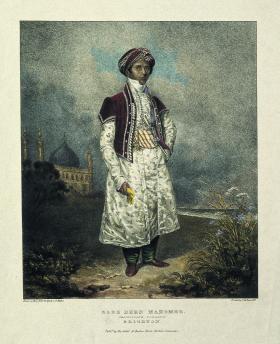Dean Mahomet: travel writer, curry entrepreneur and shampooer to the king
Published in 18th–19th - Century History, Issue 5 (Sep/Oct 2007), News, Volume 15
The National Portrait Gallery in London is home to many thousands of portraits, photographs and sculptures of the great and the good, as well as those who travelled on the darker side of history. Earlier this year it hosted a small exhibition in the Porter Gallery called Between Worlds: Voyagers to Britain 1700–1850. The exhibition focused on a dozen or so individuals over that period who travelled—mostly willingly—many thousands of miles from their native lands of India, Australia, North America, Africa and other places to Britain, where their extraordinary presence, cultures and appearance, even over a short period of time, was to have a lasting effect. One of these individuals had a strong connection with Ireland, and the exhibition features his small red shoes, waistcoat, advertisements and portraits from his period of celebrity, although there is much more to the story of Dean Mahomet, a pioneer and writer of one of the earliest travel books.
When the British Empire was at its height, it ruled over colonies worldwide. India was the sparkling ‘jewel in the crown’, though, and it had a special place in the hearts of the many who went there to seek their fortune in cotton, opium and other trades. Sake Dean Mahomet (or, in Arabic, Shaykh Din Muhammad—the name derives from Din, Arabic for ‘religion’) was born in Patna in 1759, and grew up a Muslim in Bengali Northern India, where he had watched the area slowly succumb to the might of the British East India Company. It was nothing unusual, then, when at the age of eleven he attached himself as a camp-follower to Ensign Godfrey Evan Baker, a Protestant Anglo-Irish officer in the Bengal Army. Over the following years Mahomet fought in several battles and moved up through the ranks.
It was a friendship that lasted until Baker’s death, but even though there were many more Indians than Europeans working for the company it was still a difficult choice for Mahomet: for the rest of his days he would always fight against discrimination and be called an ‘Irish Indian’ by both the British and his Indian countrymen. After Baker resigned in disgrace in 1782, they both travelled to Ireland and arrived in Cork in 1787. As Mahomet was learning English in Cork, he could hardly have dreamed that he would eventually become a friend to royalty and be celebrated as the man who introduced the curry house, aromatherapy and the sauna culture to England—as well as arguably being one of the earliest travel writers.
Mahomet caused a sensation when he eloped with and married a young Protestant gentlewoman called Jane Daly. In 1794 he published a two-volume book that he had been forming in his head since his arrival on Irish soil. The travels of Dean Mahomet, written as ‘a series of letters to a friend’, recounted the country he had left behind and the peoples and customs he had encountered while marching across northern India as part of the East India Company’s military conquest. It was the first book written and published by an Indian in English, and made him a celebrity of sorts, especially amongst the society élite. His kind representations of Indian peoples and Islamic beliefs distinguished his work from those of other European writers (even though he’d supported the British regime and was now thoroughly Anglicised), but sadly it didn’t change colonial attitudes.
After over two decades in Cork, Mahomet and his family left Ireland for London, arriving in 1807. Here he changed tack and worked as a therapeutic practitioner—then called a ‘shampooer’—for a rich nobleman. Then in 1809 he looked back to his roots and opened the rather confusingly named ‘Hindustani Coffee House’, which was one of the first curry restaurants in London and offered the ‘nobility and gentry’ the enjoyment of ‘Indian dishes of the highest perfection’. Although the business was not a success, it was honoured nearly 200 years later on 29 September 2005, when the City of Westminster unveiled a green plaque commemorating the site on George Street.
In 1814 Mahomet and his family moved to the seaside town of Brighton, where the Royal Pavilion was being ‘Indianised’, and he opened ‘Mahomed’s Baths’, where he practised his ‘Oriental medicine’ for an ever-curious public. Said to be a cure for many diseases, including gout, stiff joints and aches and pain, he used techniques of therapeutic oil massage—an early form of aromatherapy—and other luxuries such as Indian-powder and hair dyes. It was an immediate success, and ‘Dr Brighton’ now hit the heights of his fame, ultimately becoming ‘shampooing surgeon’ to King George IV and King William IV. Despite never gaining total acceptance in several cultures, his clever advertising skills and two more books—Cases cured and the autobiographical Shampooing Surgeon, Inventor of the Indian medicated Vapour and Sea Water Baths etc.—made Dean Mahomet an immigrant pioneer and entrepreneur who was years ahead of his time.
Today he would be a successful and wealthy businessman, but back in the 1800s his celebrity and entrepreneurial skills were not enough, and he all but faded into the background. He was almost totally forgotten by the time of his death in 1851, other than some material in the Royal Pavilion in Brighton and occasional mentions in other books. Poet and scholar Alamgir Hashmi drew attention to Mahomet in the 1970s and ’80s; in 1997 Michael H. Fisher edited his journals; and this year—for a few months at least—Between Worlds again highlighted his importance to contemporary English/Indian society.
James Bartlett is a writer and journalist living in Los Angeles.
Opposite page: Sake Dean Mahomet in court robes. (Welcome Trust)
















